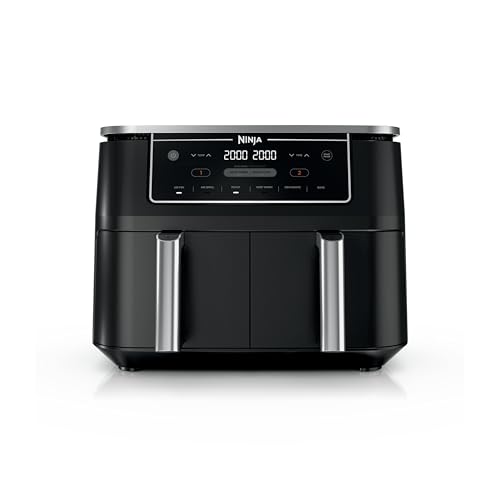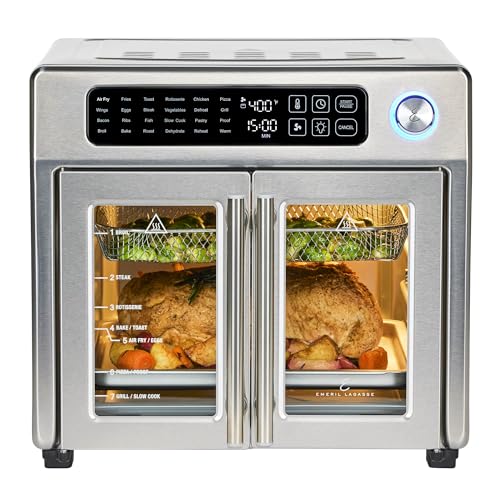Choosing between an air fryer and a convection oven can be confusing, especially when both appliances promise crispy, delicious results with less oil Usage. While they share similar technology, these kitchen workhorses have distinct differences that affect cooking time, energy usage, health benefits, and overall performance. This comprehensive guide will help you understand which appliance best suits your cooking needs.
Understanding the Technology
What is an Air Fryer?
An air fryer is a compact countertop appliance that circulates hot air at high speed around food to create a crispy, fried-like texture with minimal oil. Despite its name, an air fryer doesn’t actually fry food—it’s essentially a small, powerful convection oven optimized for rapid air circulation. The heating element is typically located at the top, with a fan that pushes hot air down and around the food in a perforated basket.
What is a Convection Oven?
A convection oven is a full-sized or countertop oven equipped with a fan and exhaust system that circulates hot air throughout the cooking chamber. This fan can be built into a traditional oven or exist as a standalone countertop unit. The circulating air eliminates hot spots and cooks food more evenly than conventional ovens, which rely solely on radiant heat.
Air Fryer
Convection Oven
Air Fryer vs Convection Oven: Health Comparison
Both appliances offer health advantages over traditional deep frying, but there are nuances to consider.
Oil Usage and Fat Reduction
Air fryers typically require only 1-2 tablespoons of oil (or none at all) to achieve crispy results, compared to the cups of oil needed for deep frying. This can reduce fat content by 70-80% compared to traditionally fried foods. Convection ovens offer similar benefits, as they also cook food with minimal added fat while achieving browning and crispiness.
Nutrient Retention
Both appliances cook food at high temperatures, which can affect nutrient content. However, because air fryers and convection ovens cook faster than conventional ovens, they may help preserve heat-sensitive vitamins and minerals. The key is avoiding overcooking, which degrades nutrients regardless of the cooking method.
Acrylamide Formation
Acrylamide is a potentially harmful chemical that forms when starchy foods are cooked at high temperatures (above 248°F/120°C). Both air fryers and convection ovens can produce acrylamide in foods like potatoes and bread. The formation depends more on cooking temperature and time than the specific appliance. To minimize acrylamide, avoid overcooking or burning food, soak potatoes before cooking, and cook at lower temperatures when possible.
The Verdict on Health
Neither appliance has a significant health advantage over the other. Both are healthier alternatives to deep frying and produce similar results with minimal oil. The healthfulness of your meals depends more on what you cook and how you prepare it than which appliance you use.
Cooking Time Comparison
One of the most significant differences between air fryers and convection ovens is cooking speed.
Air Fryer Cooking Times
Air fryers are notably faster than most ovens due to their compact size and powerful fan system. The small cooking chamber heats up in 2-3 minutes, and food cooks approximately 20-30% faster than in a conventional oven. For example, chicken wings might take 20-25 minutes in an air fryer versus 35-40 minutes in a regular oven.
Convection Oven Cooking Times
Convection ovens cook about 25% faster than conventional ovens but are generally slower than air fryers. A full-sized convection oven takes 10-15 minutes to preheat, which adds to total cooking time. However, for large batches or multiple dishes, the time difference becomes less significant because you can cook more food at once.
Time Efficiency Winner
For small portions and quick meals, air fryers are unbeatable. For large batches, family meals, or multiple dishes, convection ovens may actually save time despite slower cooking speeds, as you won’t need to cook in multiple batches.
Energy Usage and Efficiency
Energy costs and environmental impact are increasingly important factors in appliance selection.
Air Fryer Energy Consumption
Air fryers are remarkably energy-efficient. Most models use between 800-1,500 watts and cook food quickly in a small space, meaning they run for shorter periods. The rapid preheating (2-3 minutes) and faster cooking times translate to lower overall energy consumption. An air fryer might use 0.5-0.8 kWh for a typical 30-minute cooking session.
Convection Oven Energy Consumption
Full-sized convection ovens use 2,000-5,000 watts, depending on size and features. Even countertop convection ovens typically use 1,500-2,500 watts. The longer preheating time and larger cooking chamber mean more energy is required to reach and maintain cooking temperature. A convection oven might use 1.5-2.5 kWh for the same cooking session.
Energy Efficiency Winner
Air fryers are significantly more energy-efficient for small to medium portions. They can use up to 50% less energy than a full-sized convection oven. However, if you’re cooking large quantities and would need to run the air fryer multiple times, a convection oven becomes more efficient.
Temperature Conversion and Settings
Understanding how to convert temperatures between appliances ensures optimal cooking results.
General Conversion Rules
When converting a regular oven recipe to an air fryer, reduce the temperature by 25°F (15°C) and check for doneness about 20% earlier than the recipe suggests. For convection ovens, reduce the temperature by 25°F and check food a few minutes early. Many modern convection ovens have a “convection conversion” feature that automatically adjusts temperature and time.
Why Temperature Adjustments Matter
The intense air circulation in both appliances transfers heat more efficiently than conventional ovens, meaning food cooks faster and can brown more quickly. Lowering the temperature prevents burning while ensuring the inside cooks through. Air fryers, with their more concentrated heat and smaller space, may require even more careful temperature monitoring than convection ovens.
Practical Conversion Example
- Conventional oven: 400°F for 30 minutes
- Convection oven: 375°F for 25 minutes
- Air fryer: 375°F for 20-22 minutes

Air Fryer vs Regular Oven
The comparison between air fryers and standard ovens highlights even more dramatic differences.
Cooking Performance
Regular ovens cook through radiant heat from top and bottom elements, leading to uneven cooking and longer times. They excel at baking delicate items like cakes and breads. Air fryers and convection ovens both outperform standard ovens for crisping, browning, and cooking speed, but regular ovens offer gentler, more even heat for specific baking applications.
Capacity Differences
Standard ovens provide significantly more cooking space—typically 3-5 cubic feet compared to an air fryer’s 2-10 quarts. This makes regular ovens essential for large roasts, multiple sheet pans, or holiday cooking. Air fryers work best for 2-4 servings.
When to Choose Each
Choose a regular oven for baking cakes, breads, and pastries; cooking large roasts or turkeys; preparing multiple dishes simultaneously; and holiday or party cooking. Choose an air fryer for quick weeknight dinners, reheating leftovers, cooking for 1-4 people, and achieving crispy textures with minimal oil.
Air Fryer vs Toaster Oven
Toaster ovens represent another popular countertop cooking option, and many modern models now include air fryer functions.
Functionality Overlap
Many newer toaster ovens include a convection or “air fry” setting, blurring the lines between appliances. These hybrid units offer versatility but may not perform as well as dedicated air fryers due to less powerful fans or suboptimal basket designs.
Size and Space
Toaster ovens typically offer more interior space than air fryers and can accommodate a 9×13-inch pan or small pizza. Air fryers are more compact but have limited capacity. If counter space is tight, a toaster oven with an air fry function might be the best compromise.
Best Use Cases
Toaster ovens excel at toasting bread, baking small batches of cookies, reheating pizza, and broiling. Air fryers are superior for achieving maximum crispiness on foods like french fries, wings, and breaded items. If you must choose one, consider which cooking tasks you perform most often.
Pros and Cons: Complete Breakdown
Air Fryer Advantages
Pros:
- Extremely fast cooking and preheating
- Energy-efficient for small portions
- Achieves maximum crispiness
- Compact and portable
- Easy to clean (dishwasher-safe parts)
- Perfect for 1-4 servings
- Minimal oil needed
- Doesn’t heat up the kitchen
Cons:
- Limited capacity
- Can’t bake delicate items well
- Requires batch cooking for larger families
- Takes up counter space
- Can be noisy
- Limited versatility compared to full ovens
- Food can dry out if overcooked
Convection Oven Advantages
Pros:
- Much larger capacity
- Can cook multiple dishes simultaneously
- More versatile for different cooking methods
- Better for baking and roasting
- Suitable for family-sized meals
- Can handle large items (whole chickens, roasts)
- May be built into your kitchen
- Better temperature control
Cons:
- Longer preheating time
- Uses more energy
- Takes up significant space (full-sized) or counter space (countertop)
- More expensive initially
- Takes longer to clean
- May cook too quickly for delicate baking
- Heats up the kitchen more
Which Is Better? The Final Verdict
The answer depends entirely on your cooking needs, household size, and lifestyle.
Choose an Air Fryer If You:
- Cook for 1-4 people regularly
- Want the fastest cooking times
- Prioritize energy efficiency
- Make quick weeknight meals
- Love crispy foods (fries, wings, vegetables)
- Have limited cooking time
- Want to avoid heating up the kitchen
- Reheat leftovers frequently
Choose a Convection Oven If You:
- Cook for families of 5 or more
- Bake frequently
- Need to prepare multiple dishes simultaneously
- Cook large roasts, whole chickens, or turkeys
- Want maximum versatility
- Don’t mind longer cooking times
- Have counter space or already have one built-in
- Entertain frequently
The Best Solution: Both
If your budget and space allow, having both appliances provides maximum flexibility. Use the air fryer for quick, small-batch cooking and achieving ultimate crispiness, and use the convection oven for larger meals, baking, and entertaining. Many households find this combination covers all their cooking needs.
Practical Tips for Success
Maximizing Air Fryer Performance
- Don’t overcrowd the basket—air needs to circulate
- Shake or flip food halfway through cooking
- Use a light spray of oil for maximum crispiness
- Preheat for 2-3 minutes before adding food
- Line the bottom with parchment paper for easy cleanup
- Check food earlier than recipe suggests to prevent overcooking
Maximizing Convection Oven Performance
- Use low-sided pans to allow air circulation
- Reduce recipe temperatures by 25°F
- Leave space between dishes for airflow
- Rotate pans halfway through for even cooking
- Avoid using the convection setting for delicate cakes
- Keep the fan and heating elements clean
Making Your Decision
Both air fryers and convection ovens are valuable kitchen tools that can transform your cooking. Consider your household size, cooking habits, available space, and budget. An air fryer offers unmatched speed and efficiency for small households, while a convection oven provides versatility and capacity for larger families. Neither is objectively “better”—they simply excel in different scenarios.
Whichever you choose, both appliances will help you create healthier, more delicious meals with less effort than traditional cooking methods. The key is understanding their strengths and using them for what they do best.







Leave a Reply